| |
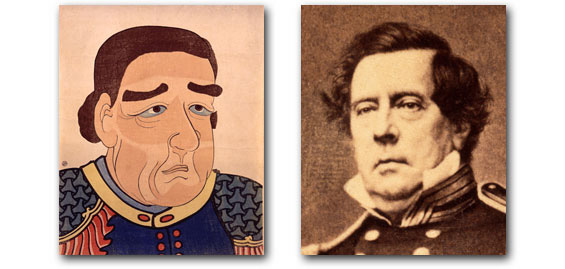 |
 Perry,
ca. 1854 Perry,
ca. 1854 |
Perry, ca. 1856 |
 |
 ©
Nagasaki Prefecture ©
Nagasaki Prefecture |
by Mathew Brady,
Library of Congress
|
On
July 8, 1853, residents of Uraga on the outskirts of Edo, the sprawling
capital of feudal Japan, beheld an astonishing sight. Four foreign
warships had entered their harbor under a cloud of black smoke, not
a sail visible among them. They were, startled observers quickly learned,
two coal-burning steamships towing two sloops under the command of
a dour and imperious American. Commodore Matthew Calbraith Perry had
arrived to force the long-secluded country to open its doors to the
outside world. |

“The Spermacetti Whale”
by J. Stewart, 1837
New Bedford Whaling Museum |
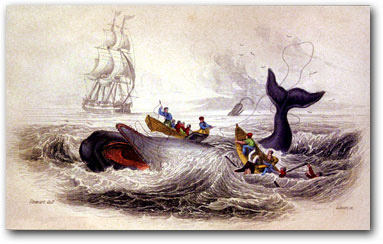 |
|
This
was a time that Americans can still picture today through Herman
Melville’s great novel Moby Dick,
published in 1851—a time when whale-oil lamps illuminated
homes, baleen whale bones gave women’s skirts their copious
form,
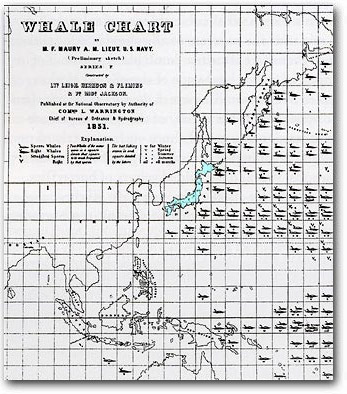
Whale
Chart, Japan in blue (detail, color added)
by M.F. Maury, US Navy, 1851
New Bedford Whaling Museum
|
and much industrial machinery was lubricated with the
leviathan’s oil. For several decades, whaling ships departing
from New England ports had plied the rich fishery around Japan,
particularly the waters near the northern island of Hokkaido.
They were prohibited from putting in to shore even temporarily
for supplies, however, and shipwrecked sailors who fell into
Japanese hands were commonly subjected to harsh treatment.
This situation could not last.
“If that double-bolted land, Japan, is ever to become
hospitable,” Melville wrote in Moby Dick, “it
is the whaleship alone to whom the credit will be due, for already
she is on the threshold.” One of the primary objectives
of Perry’s expedition was to demand that castaways be
treated humanely and whalers and other American vessels be provided
with one or two ports of call with access to “coal, provisions,
and water.”
The
message Perry brought to Japan’s leaders from President Millard
Fillmore also looked forward, in very general terms, to the eventual
establishment of mutually beneficial trade relations. On the surface,
Perry’s
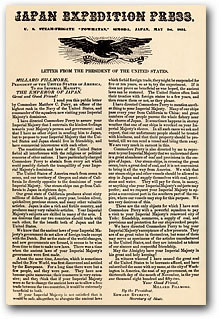
President
Fillmore’s
1853 letter to
“The Emperor of Japan”
|
demands seemed relatively modest. Yet, as his own career
made clear, this was also a moment when the world stood on the cusp
of phenomenal change.
Nicknamed “Old Bruin” by one of his early crews (and “Old
Hog” and other disparaging epithets by crewman with the Japan
squadron), Matthew Perry was the younger brother of Oliver Hazard
Perry, hero of the American victory over the British on Lake Erie
in 1813. His own fame as a wartime leader had been established in
the recent U.S. war against Mexico, where he commanded a squadron
that raided various ports and supported the storming of Vera Cruz.
Victory over Mexico in 1848 did not merely add California to the United
States. It also opened the vista of new frontiers further west across
the Pacific Ocean. The markets and heathen souls of near-mythic “Asia” now beckoned more enticingly than ever before. Mars, Mammon, and God
traveled hand-in-hand in this dawning age of technological and commercial
revolution.
U.S. merchant firms had been involved in the China trade centering
on Canton since the previous century. Indeed, “Chinoiserie”—elegant
furnishings and objects d’art imported from the Far East, or
else mimicking Chinese and Japanese art and artifacts—graced
many fashionable European and American homes from the late-17th century
on. Following England’s victory in the Opium War of 1839-1842,
the United States joined the system of “unequal treaties”
that opened additional Chinese ports to foreign commerce. Tall, elegant
Yankee clipper ships engaged in a lively commerce that included not
merely Oriental luxuries such as silks, porcelains, and lacquer ware,
but also opium (for China) and Chinese coolies (to help build America’s
transcontinental railway). Now,
as Perry would ponderously convey to the Japanese, ports on the West
Coast such as San Francisco were opening up as well. In the new age
of steam-driven vessels, the distance between California and Japan
had been reduced to but 18 days. Calculations concerning space,
and time, and America’s “manifest destiny” itself
had all been dramatically transformed.
For Americans, Perry’s expedition to Japan was but one momentous
step in a seemingly inexorable westward expansion that ultimately spilled across the Pacific
to embrace the exotic “East.” For the Japanese, on the
other hand, the intrusion of Perry’s warships was traumatic,
confounding, fascinating, and ultimately devastating.
For almost a century prior to the 1630s, Japan had in fact engaged
in stimulating relations with European trading ships and Christian
missionaries. Widely known as the “southern barbarians” (since they arrived from the south, after sailing around India and
through the South Seas), these foreigners established a particularly
strong presence in and around the great port city of Nagasaki on the
southern island of Kyushu. Spain, Portugal, Holland, and England engaged
in a lucrative triangular trade involving China as well as Japan.
Protestant missionaries eventually followed their Catholic predecessors
and rivals, and by the early-17th century Christian converts in Kyushu
were calculated to number many tens of thousands. (Catholic missionaries put the figure at around a quarter
million.) At the same time, Japanese culture had become enriched by
a brilliant vogue of “Southern Barbarian” art—by
artwork, that is, that depicted the Europeans in Japan as well as
the lands and cultures from which they had come. This new world of
visual imagery ranged from large folding screens depicting the harbor
at Nagasaki peopled with foreigners and their trading ships to both
religious and secular paintings copied from European sources.
|
 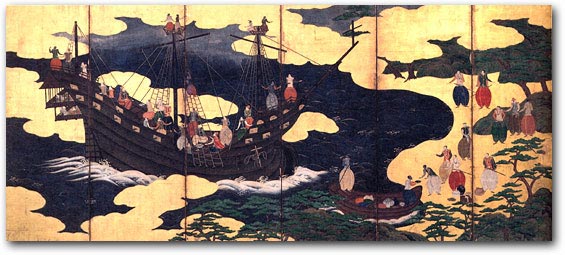
The arrival of “Southern Barbarians,” 17th-century folding screen
Nagasaki Prefecture |
During these same decades, the Japanese themselves were venturing abroad. Their voyagers established footholds in Siam and the Philippines, for example, and a small delegation of Japanese Christians actually visited the Vatican. The country seemed poised to join in the great age of overseas expansion.
All this came to an abrupt end in 1639, when the ruling warrior government enforced a strict “closed country” (sakoku) policy: Japanese were forbidden to travel abroad, foreigners were expelled, and Christian worship was forbidden and cruelly punished. |
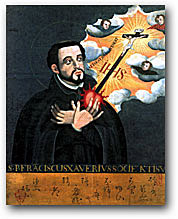
17th-century Japanese portrait of Francis
Xavier, the Spanish Jesuit who introduced Christianity to
Japan in the mid-16th century
Kobe City Museum
|
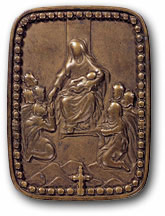
Fumie of Virgin Mary
with Christ child
Shiryo Hensanjo,
University of Tokyo
|
"Hidden Christians” reluctant to recant were ferreted out by forcing them to step on pictures or metal bas-reliefs of Christian icons such as the crucifixion or the Virgin Mary known as fumie (literally, “step-on pictures”), and observing their reactions—a practice the Japanese sometimes forced American castaways to do as well.
The rationale behind the draconian seclusion policy was both strategic and ideological. The foreign powers, not unreasonably, were seen as posing a potential military threat to Japan; and it was feared, again not unreasonably, that devotion to the Christian Lord might undermine absolute loyalty to the feudal lords who ruled the land.
The most notable small exception to the seclusion policy was the continued presence of a Dutch mission confined to Dejima, a tiny, fan-shaped, artificial island in the harbor at Nagasaki. Through Dejima and the Dutch, the now isolated Japanese maintained a small window on developments in the outside world.
|
|
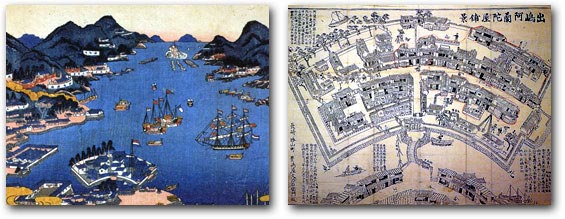 |
The “fan-shaped” island of
Dejima in Nagasaki harbor,
where the Dutch were
permitted to maintain
an enclave during
the period of seclusion
Nagasaki Prefecture (above left)
Peabody Essex Museum |
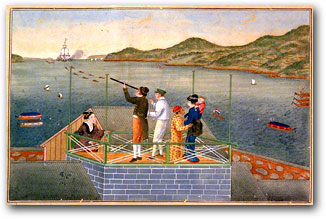 |
|
Under
the seclusion policy, the Japanese enjoyed over two centuries of insular
security and economic self-sufficiency. Warriors became bureaucrats. Commerce flourished.
Major highways laced the land. Lively towns dotted the landscape,
and great cities came into being. At the time of Perry’s arrival,
Edo (later renamed Tokyo) had a population of around one million.
The very city that Perry’s tiny fleet approached in 1853 was
one of the greatest urban centers in the world—although the
outside world was unaware of this.
As it turned out, Perry himself never got to see Edo. Although his
mission to open Japan succeeded in every respect, the negotiations
took place in modest seaside locales. It remained for those who followed
to tell the world about Japan’s extraordinary capital city.
While the Japanese did not experience the political, scientific, and
industrial revolutions that were sweeping the Western world during
their two centuries of seclusion, these developments were not unknown
to them. Through the Dutch enclave at Dejima, a small number of Japanese
scholars had kept abreast of “Dutch studies” (Rangaku)
and “Western studies” (Yogaku). And as news of
European expansion filtered in, the feudal regime in Edo became alarmed
enough to relax its anti-foreign strictures and permit the establishment
of an official “Institute for the Investigation of Barbarian
Books.”
One of the earliest accounts of North America to appear in Japanese,
published in 1708, reflected more than a little confusion: it referred
to “a country cold and large…with many lions, elephants,
tigers, leopards, and brown and white bears,” in which “the
natives are pugnacious and love to fight.” As happens in secluded
societies everywhere, moreover, there existed a subculture of fabulous
stories about peoples inhabiting far-away places.
An 18th-century scroll titled “People of Forty-two Lands,”
for example, played to such imagination with illustrations of figures
with multiple arms and legs, people with huge holes running through
their upper bodies, semi-human creatures feathered head to toe like
birds, and so on.
|
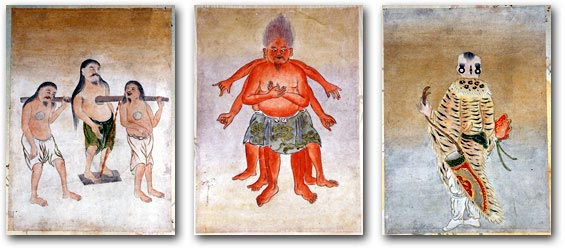 |
 “People
of Forty-two Lands” (details),
ca. 1720 “People
of Forty-two Lands” (details),
ca. 1720
Ryosenji Treasure Museum |
Such
grotesqueries belonged to a larger fantasy world of supernatural beings
that had countless visual representations in popular art. Throughout
the period of seclusion, however, naturalistic depictions of Europeans
in the tradition of the “Southern Barbarian” artwork continued
to be produced, particularly depicting the daily life of the “red
hairs,” as the Dutch in Dejima were commonly known.
|
Dutch dinner party
by Kawahara Keiga,
early-19th century
Peabody Essex Museum
 |
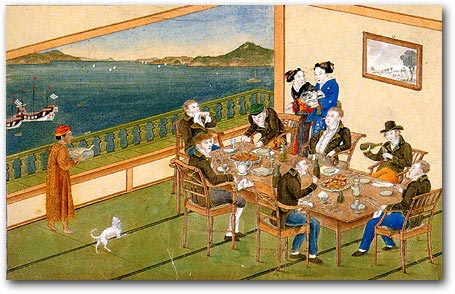 |
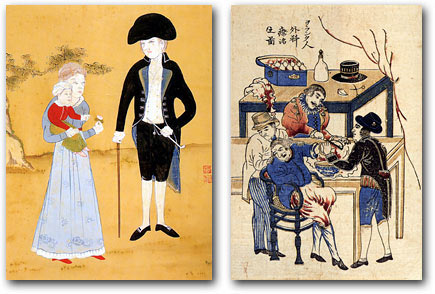
|
Dutch family
by Jo Girin, ca. 1800
Peabody
Essex Museum
Dutch “surgery”
Kobe
City Museum
 |
Concrete
knowledge of the West, including the United States, deepened over
time. The Japanese obtained Chinese translations of certain American
texts, including a standard history of the United States, and the
very eve of Perry’s arrival saw the publication of both a full-length
“New History of America” (which, among other things, singled
out egalitarianism, beef eating, and milk drinking) and a “General
Account of America” that described the Americans as educated
and civilized, and stated that they should be met “with respect
but not fear.”
|
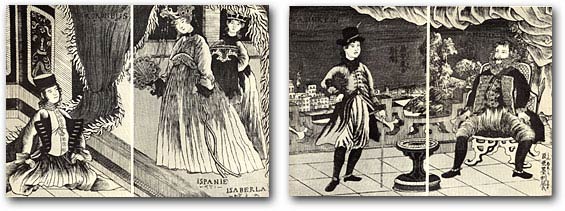 |
Illustrations
from a Japanese book about the United States published on the eve
of Perry’s
arrival included imaginary renderings of “Columbus and Queen
Isabella” (left)
and “George Washington and Amerigo Vespucci” (!)
Collection of Carl H. Boehringer
|
The most vivid and intimate information available to Japanese officials
prior to Perry’s arrival came from “John Manjiro,”
a celebrated Japanese youth who had been shipwrecked while fishing
off the Japanese coast in 1841. Only 14 years old at the time,
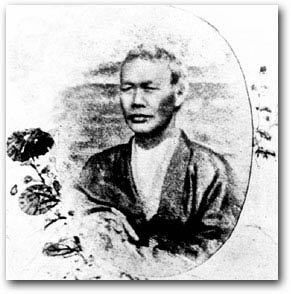
 John
Manjiro John
Manjiro |
Manjiro was rescued by an American vessel and brought to the United
States. He lived in Fairhaven, Massachusetts for three years, sailed
for a while on an American whaler, and even briefly joined the gold
rush to California in 1849. When Manjiro finally made his way back
to Japan in 1851, samurai officials interrogated him at great length.
Manjiro praised the Americans as a people who were “upright
and generous, and do no evil”—although he noted that they
did engage in odd practices like reading in the toilet, living in
houses cluttered with furniture, and expressing affection between
men and women in public (in this regard, he found them “lewd”
and “wanton”). Manjiro also regaled his interrogators
with accounts of America’s remarkable technological progress,
including railways, steamships, and the telegraph. An account of his
adventures prepared with the help of a samurai scholar in 1852 even
included crude drawings of a paddle-wheel steamship and a train.
When Perry’s warships appeared off Uraga at the entry to Edo
Bay, they were thus not a complete surprise. The Dutch in Dejima had
informed the Japanese that the expedition was on its way. And John
Manjiro had already described the wonders of the steam engine. As
the official report of the Perry expedition later noted, “however
backward the Japanese themselves may be in practical science, the
best educated among them are tolerably well informed of its progress
among more civilized or rather cultivated nations.” Such abstract
knowledge, however, failed to mitigate the shock of the commodore’s
gunboat diplomacy.
Perry was not the first American to enter Japanese waters and attempt
to make that double-bolted land “hospitable.” Several
American vessels flying Dutch flags had entered Nagasaki harbor around the turn of the century, intent on commerce. In 1837,
the unarmed trading ship Morrison had approached Uraga on
a private mission to promote not only trade but also “the glory
of God in the salvation of thirty-five million souls.” At Uraga,
and again at Kagoshima on the southern tip of Kyushu, the vessel was
fired on and driven off. In 1845, the whaleship Manhattan
was allowed to briefly put in at Uraga to return 22 shipwrecked Japanese
sailors.
|

 The
whaleship The
whaleship
Manhattan,
1845 watercolor by
an anonymous
Japanese artist
New Bedford
Whaling Museum |
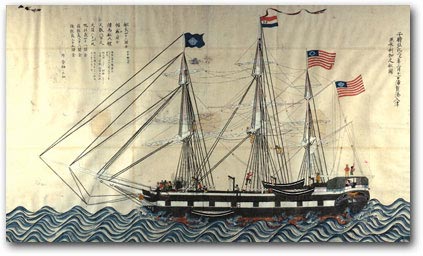 |
The
following year, two warships commanded by Commodore James Biddle entered
Edo Bay and engaged in preliminary contact with Japanese officials.
Biddle was not allowed to come ashore, however, and when ordered to
“depart immediately” did precisely as he had been told—leaving
no legacy beyond a few American and Japanese illustrations of his
warships.
|
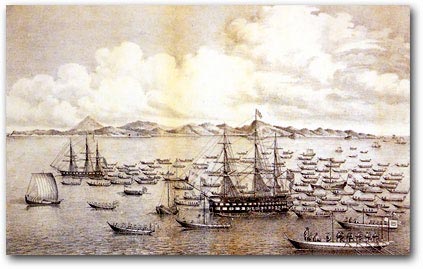 |
Lithograph depicting Commodore Biddle’s
ships anchored in Edo Bay in 1846 and surrounded by small Japanese
boats
Peabody Essex Museum

|
Perry
possessed what his predecessors had lacked: grim determination, for
one thing—and, still more intimidating, the steam-driven warships. He was not to
be denied. And the erstwhile warrior leaders in Edo, who had not actually fought any wars for almost
two-and-a-half centuries, quickly recognized that they had no alternative
but to submit to his demands. They lacked the firepower—and
all the advanced technology such power exemplified—to resist.
Perry prepared diligently for his mission, and immersed himself in
the most authoritative foreign publications available on Japan. Some
of these accounts, emanating from Europeans who had been stationed
in Dejima, provided a general overview of political, economic, and
social conditions. An American geography text described Japan in flattering
terms as “the most civilized and refined nation of Asia,”
while other accounts, dwelling on the persecution of Christians and
inhospitable treatment meted out to castaways, spoke derisively of
a land that had regressed “into barbarism and idolatry.”
In Japan and the Japanese, a small book published in America
in 1852 as a send-off to the Perry expedition, a former employee of
the British East India Company paired synopses of prior writings with
a selection of illustrations that revealed how odd and exotic the
little-known heathen still remained in the imagination of Westerners. These thoroughly
fanciful graphics conjured up a world of bizarre religious icons commingled with sturdy
men and women wearing Chinese-style robes, holding large and stiff
fan-shaped implements, even promenading with folded umbrella-like
tents draped over their heads and carried from behind by an attendant.
|
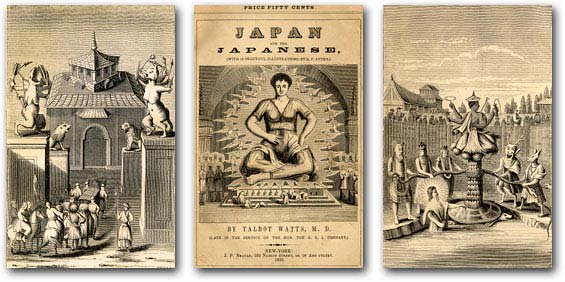
 |
Illustrations
in Japan and the Japanese (1852)
included the worshipping of idols,
“Habit of the Japanese Soldiers,” and “A Japanese
Lady of Quality”
|
Such
fantasy masquerading as informed commentary and illustration was typical.
Just months before Perry’s arrival in Japan, the popular U.S.
periodical Gleason’s Pictorial Drawing-Room Companion
published a dramatic engraving depicting “the emperor of Japan”
holding public court in “Jeddo” (the old romanized spelling
of Edo, the capital city later renamed Tokyo). Here, too—despite
being annotated with fifteen numbered details—the graphic was
entirely imaginary. The emperor lived in Kyoto rather than Edo. His
palace surroundings were not highly Sinified (“Chinese”),
as depicted here. He never held public court. And Japanese “gentlemen”
and “soldiers” did not wear costumes or sport hairstyles
of the sort portrayed.
|
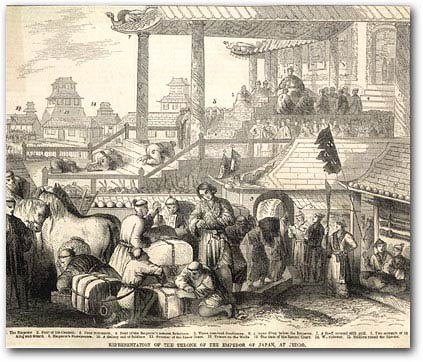 |

"Representation of the Throne of the Emperor of Japan, at Jeddo”
from the April 12, 1853 issue of
Gleason’s Pictorial |
In his private journals, Perry himself anticipated encountering “a
weak and barbarous people,” and resolved to assume the most
forbidding demeanor possible within the bounds of proper decorum.
Despite his diligent preparations, he (much like Gleason’s
Pictorial) never fully grasped where real power resided and with
whom he was dealing. The letter he carried from President Fillmore
was addressed “To His Imperial Majesty, the Emperor of Japan,”
and the report the commodore published after his mission was completed
referred repeatedly to his dealings with “Imperial Commissioners.”
The hereditary imperial house in Kyoto was virtually powerless, however,
having ceded de facto authority some seven centuries previously to
warriors headed by a Shogun, or Supreme Commander. The “Imperial
Commissioners” to whom Perry conveyed his demands were actually
representatives of the warrior government headed by the Tokugawa clan,
which had held the position of Shogun since the beginning of the 17th
century.
In practice, none of this ambiguity mattered. Perry dealt with the
holders of real authority, and through them had his way.
His 1853 visit was short. While the Japanese looked on in horror,
the Americans blithely surveyed the waters around Edo Bay. On July
14, five days after appearing off Uraga, the commodore went ashore
with great pomp and ceremony to present his demands to the Shogun’s
officials, who had gathered onshore near what was then the little
town of Yokohama, south of Edo. Perry’s entourage of some 300
officers, marines, and musicians passed without incident through ranks
of armed samurai to a hastily erected “Audience Hall”
made of wood and cloth. There Perry handed over President Fillmore’s
letter, explained that the United States sought peace and prosperity
for both countries, and announced that he would return shortly, with
a larger squadron, for the government’s answer. Three days later,
the four American vessels weighed anchor and left.
Perry made good on his heavy-handed promise some six months later,
this time arriving in early March of 1854 with nine vessels (including
three steamers), over 100 mounted guns, and a crew of close to 1,800. |
This second encounter was accompanied by far greater interaction and
socialization between the two sides. Gifts were exchanged, banquets
were held, entertainment was offered, and the Americans spent much
more time on shore, observing the countryside and intermingling with
ordinary Japanese as well as local officials. The high point of these
activities was a treaty signed on March 31 in Kanagawa, another locale
on Edo Bay, which met all of the U.S. government’s requests.
The Treaty of Kanagawa guaranteed good treatment of castaways, opened
two Japanese ports (Shimoda and Hakodate) for provisions and refuge,
and laid the groundwork for Japan’s reluctant acceptance of
an American “consul”—which, as soon transpired,
broke down the remaining barriers to Japan’s incorporation in
the global political economy.
The
Perry expeditions of 1853 and 1854 constitute an extraordinary moment
in the modern encounter between “East” and “West.”
Japan was suddenly “opened” to a world of foreign influences
and experiences that poured in like a flood and quickly seeped into
all corners of the archipelago. And the Americans—and other
foreigners who quickly followed on their heels (the British, Dutch,
French, and Russians)—abruptly found themselves face-to-face
with an “Oriental” culture that had hitherto existed primarily
as a figment of imagination. On all sides—whether facing “East”
or facing “West”—the experience was profound. Whole
new worlds became visualized in unprecedented ways.
|
 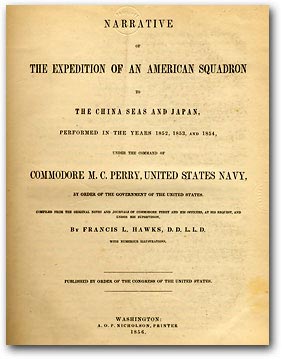
Title page of the official Narrative
of the Perry mission.
|
This
was true literally, not just figuratively. On the American side, Perry’s
entourage included two accomplished artists: William Heine and Eliphalet
Brown, Jr. Their graphic renderings— particularly Heine’s
detailed depictions of scenic sites and crowded activities—were
subsequently reproduced as tinted lithographs and plain woodcuts in
a massive official U.S. account of the expedition (published in three
volumes between 1856 and 1858, and cumbersomely titled Narrative
of the Expedition of an American Squadron to the China Seas and Japan,
performed in the years 1852, 1853, and 1854, under the Command of
Commodore M. C. Perry, United States Navy, by Order of the Government
of the United States). Additionally, a small selection of official
illustrations was made available in the form of large, independent,
brightly colored lithographs.
As
it happened, the Perry expeditions took place shortly after the invention
of daguerreotype photography (in 1839), and Eliphalet Brown, Jr. in
particular was entrusted with compiling a photographic record of the
mission. Although most of his plates were subsequently destroyed in
a fire, we still can easily imagine what was recorded through the
camera’s eye, for the official narrative also includes woodcuts
and lithographs of carefully posed Japanese that are explicitly identified
as being “from a daguerreotype.”
On the Japanese side, there was no comparable official visual record
of these encounters, although we know from accounts of the time that
boatloads of Japanese artists and illustrators rushed out to draw
the “black ships” from virtually the moment they appeared
off Uraga. What we have instead of a consolidated official collection
is a scattered treasury of graphic renderings of various aspects of
the startling foreign intrusion. The Americans were, of course, as
alien to the Japanese as the Japanese were, in their turn, to the
Americans. They were, depending on the viewer, strange, curious, fascinating,
attractive, lumpish, humorous, outlandish, and menacing—frequently
an untidy mixture of several of these traits.
Japanese artists, moreover, rendered their impressions through forms
of expression that differed from the lithographs, woodcuts, paintings,
and photographs that Europeans and Americans of the time relied on
in delineating the visual world. Vivacious woodblock prints, cruder
runs of black-and-white “kawaraban” broadsheets,
and drawings and brushwork in a conspicuously “Japanese” manner constituted the primary vehicles through which the great encounters
of 1853 and 1854 were conveyed to a wider audience in Japan. Some
of this artwork spilled over into the realm of caricature and cartoon.
The complementary but decidedly contrasting American and Japanese
images of the Perry mission and opening of Japan constitute a rare moment in the history
of “visualizing cultures.” This was, after all, an unusually
concentrated face-to-face encounter between a fundamentally white,
Christian, and expansionist “Western” nation and a reclusive
and hitherto all-but-unknown “Oriental” society. It was
also a moment during which each side produced hundreds of graphic
renderings not only of the alien foreigner, but of themselves as well.
It is tempting, and indeed fascinating, to ask which side was more
“realistic” in its renderings—but this really misses
the point. For it is only by seeing the visual record whole, in its
fullest possible range and variety, that we can grasp how complex
and multi-layered these interactions really were.
|
|
|

